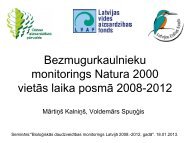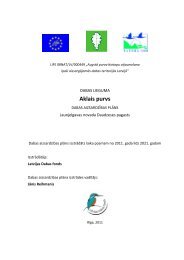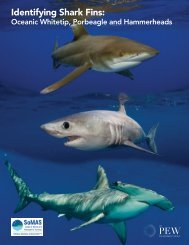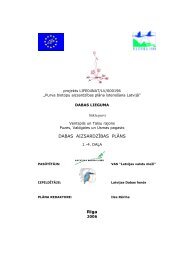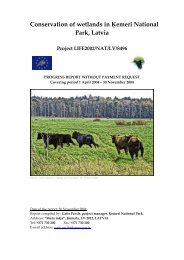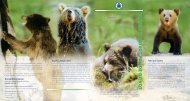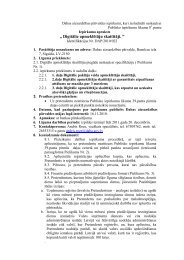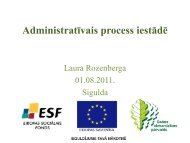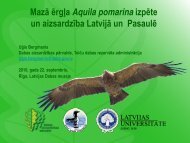BIOLOĢISKĀ DAUDZVEIDĪBA GAUJAS NACIONĀLAJĀ PARKĀ ...
BIOLOĢISKĀ DAUDZVEIDĪBA GAUJAS NACIONĀLAJĀ PARKĀ ...
BIOLOĢISKĀ DAUDZVEIDĪBA GAUJAS NACIONĀLAJĀ PARKĀ ...
Create successful ePaper yourself
Turn your PDF publications into a flip-book with our unique Google optimized e-Paper software.
i o l o Ģ i s K ā d a u d Z V e i d ī b a G a u j a s n a C i o n ā l a j ā p a R K ā<br />
saldūdens kaļķiežu atradne). Bez avotu veidotiem strautiem ir arī virszemes ūdeņu jeb nokrišņu radīti strauti.<br />
Atsevišķos strautos ir sastopamas ūdenssūnu Fontinalis vai kladoforu Cladophora audzes, tomēr vairums strautu ir<br />
bez augāja.<br />
KRAStA VEĢEtĀCIJAS IEtEKME<br />
Kā ūdensaugu daudzveidību samazinošs faktors Gaujas pietekām ir jāmin noēnojums no upes krastiem<br />
bijušajās piekrastes pļavās, kuras, apsīkstot saimnieciskajai darbībai, ir strauji aizaugušas ar alkšņiem. Šādos<br />
upju posmos no augstākajiem ūdensaugiem vairāk vai mazāk regulāri ir sastopams tikai vienkāršās ežgalvītes un<br />
dzeltenās lēpes iegremdētās formas. Šādās upēs ir izzudušas tipiskās virsūdens augu sugas kā šaurlapu vilkvālīte,<br />
ūdeņu mētra, krastmalas skābene, purva skalbe, smaržīgā kalme, dižmeldru grīslis, čemurainais puķumeldrs, ezera<br />
lielmeldrs, parastā cirvene, parastā bultene, upes kosa. Minētais process ietekmē arī šajos posmos sastopamo<br />
bezmugurkaulnieku sastāvu, samazinot organismu daudzveidību, un tādējādi radot arī zivju barības bāzes<br />
vienkāršošanos.<br />
LItERAtūRA UN CItI INfORMĀCIJAS AVOtI<br />
1. Avotiņa R. 1995. Gauja. - Enciklopēdija „Latvijas daba”. 2. Rīga, Latvijas Enciklopēdija: 97-98.<br />
2. Eipurs I., Zīverts A. 1998. Upes. - Enciklopēdija „Latvijas daba”. 6. Rīga, Preses nams: 7-9.<br />
3. Клявиня Г.Б. 1979. Флора водных прибретно-водных (цветковых) растений реки Гауя. - Флора и растетельность<br />
Латвийской ССР: Северо-Видземский геоботанический район. Рига, Зинатне: 79-85.<br />
4. Pakalne M., Āboliņa A., Čakare I., Opmanis A., Lācis A. 2002. Eiropas nozīmes un Latvijas aizsargājamie biotopi Gaujas<br />
nacionālajā parkā. Projekta atskaite. Rīga.<br />
5. Kabucis I. (red.), Bambe B., Eņģele L., Jermacāne S., Laime B., Pakalne M., Smaļinskis J., Urtāns A. 2001. Latvijas biotopi.<br />
Klasifikators. Rīga, LDF: 96 lpp.<br />
StREAMS AND SPRINGS<br />
The current article summarizes the existing biological information on stream surveys in Gauja NP. The main<br />
water course within Gauja National Park, the River Gauja, and the lower stretches of its tributaries are characterised<br />
by loose and unstable fine sand stream beds. The amount of sediments carried by the River Gauja reaches 500<br />
thousand tonnes per annum with water discharge varying from 6 m 3 /s during winter to 870 m 3 /s during spate<br />
conditions. These factors strongly influence distribution and characteristics of aquatic plant and invertebrate<br />
communities.<br />
The River Gauja is characterised by patch-like assemblages of plant communities in sheltered stream<br />
sections forming narrow belts of emerged plants like Typhoides arundinacea, Glyceria fluitans, Butomus umbellatus and<br />
Equisetum fluviatilis. Less frequently communities of Mentha aquatica, Sparganium erectum are recorded. Submerged<br />
plant communities are dominated by Potamogeton pectinatus. P. perfoliatus, P. natans, Elodea canadensis and Batrachium<br />
trichophyllum are distributed unevenly in a form of scarce assemblages.<br />
Medium-sized streams (the Amata and Brasla Rivers) are characterised by stony river beds, the presence of<br />
springs and consequent low water temperatures with plant communities dominated by aquatic mosses Fontinalis sp.<br />
and red algae (Hildebrandia rivularis). Small patches of pondweeds (Potamogeton alpinus) are distributed unevenly. The<br />
invertebrate community is dominated by oxygen-preferring species complexes.<br />
Small-sized streams and springs have rather high variations in species and habitat diversity. Thus the River<br />
Strikupe has the most diverse macrophyte assemblages while the River Kumada and the River Grube contain<br />
several protected habitats. More than 50 habitats are recorded in investigated Gauja NP streams. Still it must be<br />
assumed that obtained results are preliminary and serve as the initiation of more profound extensive surveys.



